
Sam Hallas' Website
The BT Museum Memorial Pages - Telegraphy Items -2
Hughes Printing Telegraph
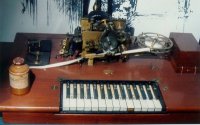 The Hughes system was a rival to the Baudot printing telegraph system. The piano key
layout required minimal training for the operators. Messages were printed on paper
tape by the type-wheel arrangement visible at the back. Power was supplied by a
weight and pulleys underneath.
The Hughes system was a rival to the Baudot printing telegraph system. The piano key
layout required minimal training for the operators. Messages were printed on paper
tape by the type-wheel arrangement visible at the back. Power was supplied by a
weight and pulleys underneath.
Reid Single Needle Telegraph Instrument
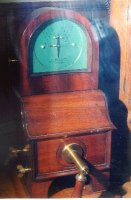 The single-needle system used alternating polarity of current to pull the needle to
one side or the other. It contacted a metal plate or peg, giving a distinctive sound
for each side. The code used was similar to Morse code, but dots and dashes were
replaced with the two different pitch notes emitted by the plates.
The single-needle system used alternating polarity of current to pull the needle to
one side or the other. It contacted a metal plate or peg, giving a distinctive sound
for each side. The code used was similar to Morse code, but dots and dashes were
replaced with the two different pitch notes emitted by the plates.
Gell Morse perforator
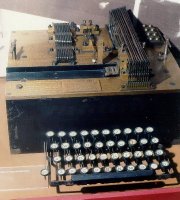 In order to maximise traffic on the expensive long-distance telegraph circuits,
automatic morse sending was common. The messages were prepared off-line on
paper tape using a machine like this. The tape was then sent at high speed
with an automatic sender.
In order to maximise traffic on the expensive long-distance telegraph circuits,
automatic morse sending was common. The messages were prepared off-line on
paper tape using a machine like this. The tape was then sent at high speed
with an automatic sender.
Morse Inker
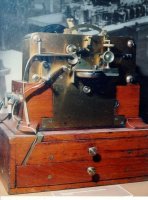 A human operator could not receive the high-speed Morse transmissions sent by the above means. This device made ink marks on the strip of paper visible passing between the rollers. The tape could then be decoded at leisure.
A human operator could not receive the high-speed Morse transmissions sent by the above means. This device made ink marks on the strip of paper visible passing between the rollers. The tape could then be decoded at leisure.
Murray Keyboard
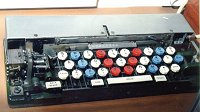 Invented in 1902 by New Zealander, Donald Murray, this printing telegraph
system was based on the Baudot multiplex system but the code used was designed
to minimise mechanical wear, rather than be easy to remember.
Invented in 1902 by New Zealander, Donald Murray, this printing telegraph
system was based on the Baudot multiplex system but the code used was designed
to minimise mechanical wear, rather than be easy to remember.
Post Office Perforator
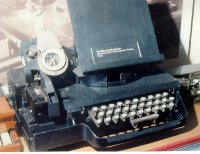 From the Creed factory in Croydon, the Post Office Perforator No1 was used
to prepare Telex tape off line. A character counter caused the lamp on the left
to light when a line of text was nearly full, allowing the operator to enter
a carriage return and line feed at the appropriate point.
From the Creed factory in Croydon, the Post Office Perforator No1 was used
to prepare Telex tape off line. A character counter caused the lamp on the left
to light when a line of text was nearly full, allowing the operator to enter
a carriage return and line feed at the appropriate point.
Teleprinter No 7
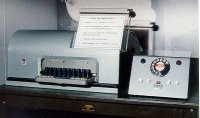 Introduced in the 1930s, this page-printing teleprinter was the mainstay of
the Post office's Telex service for over 30 years. The type head is fixed and
the platen moves from right to left. The unit on the right form the interface
between the printer and the Telex network allowing the user to connect calls
automatically using the dial.
Introduced in the 1930s, this page-printing teleprinter was the mainstay of
the Post office's Telex service for over 30 years. The type head is fixed and
the platen moves from right to left. The unit on the right form the interface
between the printer and the Telex network allowing the user to connect calls
automatically using the dial.
Stock Ticker
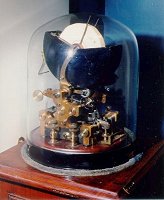 The traditional stock ticker as seen in many films. The messages are printed
on paper tape which exits from the printer at the bottom right.
The traditional stock ticker as seen in many films. The messages are printed
on paper tape which exits from the printer at the bottom right.
Cheetah Electronic Telex
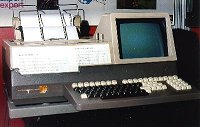 The Cheetah brought to telex operation all the advantages of a word processor -
screen editing, near silent operation when sending, etc. However, the
electronic telex machine had a short lifespan compared with its mechanical
predecessor, which reigned supreme for over forty years. This was mainly
due to the rapid rise of the personal computer, which, with
minimal additional hardware, could outperform this dedicated hardware and do a lot
else besides.
The Cheetah brought to telex operation all the advantages of a word processor -
screen editing, near silent operation when sending, etc. However, the
electronic telex machine had a short lifespan compared with its mechanical
predecessor, which reigned supreme for over forty years. This was mainly
due to the rapid rise of the personal computer, which, with
minimal additional hardware, could outperform this dedicated hardware and do a lot
else besides.
Exhibits: British Telecom Collection
Photos: copyright Sam Hallas 1992-1997
Telecomms Index
 The Hughes system was a rival to the Baudot printing telegraph system. The piano key
layout required minimal training for the operators. Messages were printed on paper
tape by the type-wheel arrangement visible at the back. Power was supplied by a
weight and pulleys underneath.
The Hughes system was a rival to the Baudot printing telegraph system. The piano key
layout required minimal training for the operators. Messages were printed on paper
tape by the type-wheel arrangement visible at the back. Power was supplied by a
weight and pulleys underneath.








 Back
Next
Back
Next
